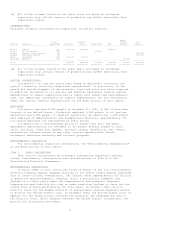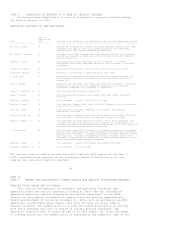Occidental Petroleum 2001 Annual Report Download - page 19
Download and view the complete annual report
Please find page 19 of the 2001 Occidental Petroleum annual report below. You can navigate through the pages in the report by either clicking on the pages listed below, or by using the keyword search tool below to find specific information within the annual report. PVC resin prices increased only slightly in the first half of 2001, but
declined throughout the remainder of the year. Higher exports in 2001 prevented
operating rates from falling lower, but export sales returned only minimal
margins.
On June 1, 2001, OxyChem temporarily idled its Ingleside, TX ethylene
dichloride (EDC) plant and on December 27, 2001, OxyChem temporarily idled the
Deer Park chlor-alkali plant in Houston, TX due to a combination of
deteriorating prices and weak demand. These facilities will remain idle until
economic conditions improve.
In Occidental's chlor-alkali business, reduced demand for chlorine led to
significantly reduced operating rates. OxyChem's operating rate, as a percent of
capacity, fell from 92 percent in 2000 to 84 percent in 2001. The chlorine
industry's 2001 operating rate was 85 percent compared to 92 percent for 2000.
Despite reduced liquid caustic production, caustic prices declined in the second
half of the year on weak demand. As 2001 progressed, chlorine prices fell due to
declining demand, especially in the global vinyls market. Operations at the
Convent chlor-alkali and EDC plant, which had been curtailed, were recommenced
in 2001.
Record-high energy costs in the first quarter of 2001 adversely affected
earnings. For the total year, energy costs were higher than 2000, but well below
first quarter levels. Feedstock costs followed the same trend as energy costs.
Petrochemical margins were under pressure throughout 2001 due to weak
demand and significant capacity additions by BASF/AtoFina, Formosa Plastics and
Union Carbide/Nova Chemical. Lower feedstock costs in the fourth quarter were
offset by lower prices due to continued weak demand.
The primary goal of Occidental's chemical business is to provide free cash
flow. From 1995 through 2001, total cash flow from the chemicals business was
$3.8 billion, including asset sales, net of acquisitions, of $1.0 billion.
2002 OUTLOOK
OIL AND GAS
The petroleum industry is highly competitive and subject to significant
volatility due to numerous market forces. Crude oil and natural gas prices are
affected by market fundamentals such as weather, inventory levels, competing
fuel prices, overall demand and the availability of supply.
16
In the fourth quarter of 2001, worldwide oil prices weakened considerably
and have remained lower than their ten-year averages in the first quarter of
2002. Sustained low prices will significantly impact profitability and returns
for Occidental and other upstream producers. However, the industry has
historically experienced wide fluctuations within price cycles.
While fundamentals are a decisive factor affecting crude oil prices over
the long term, day-to-day prices may be more volatile in the futures markets;
such as on the NYMEX and other exchanges, which make it difficult to accurately
predict oil and natural gas prices. In the short term, other factors such as
weather patterns do have a significant effect, particularly on natural gas
prices. In the United States, increased gas supplies from large capital
investment over the past year, combined with a later winter, resulted in
inventory levels at the end of 2001 exceeding the average of the preceding five
years by 20 percent.
The combination of higher gas supplies and lower demand, which is
continuing into the first quarter of 2002, is expected to result in
significantly lower average gas price realizations for Occidental in 2002 than
in 2001.
CHEMICAL
The performance of the chemical business is difficult to forecast, but this
business is capable of contributing significant earnings and cash flow when
demand is strong.
Industry operating rates in the chlor-alkali/vinyls business are expected
to recover gradually in 2002.
CHLOR-ALKALI
Domestic chlorine demand is expected to increase by nearly 2 percent in
2002, which should allow the industry's operating rates to improve in the
absence of capacity additions. Liquid caustic pricing is expected to continue to
be weak.
























